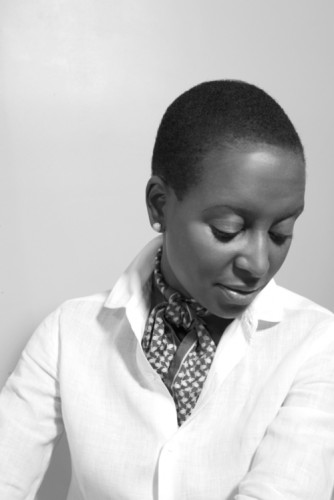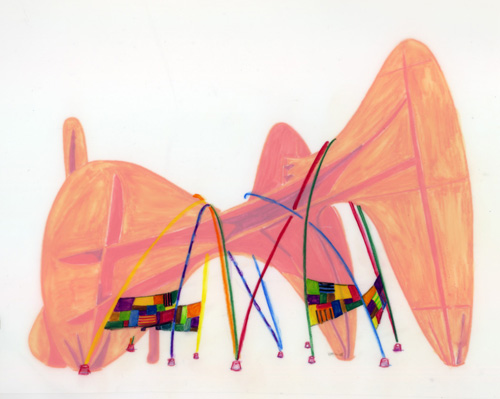Last month, Kianga Ellis and I participated in a panel discussion about the New York art world at 3RD Ward in Bushwick. The talk, organized by Krista Saunders, also featured Henry Chung, Robert Walden, and Laura Pinello. It was standing room only, and money was on a lot of people’s minds. At one point in the conversation, Kianga said to the audience: “Why would anyone listen to a derivatives lawyer talk about contemporary art?”
Kianga, before she became the Director of Kianga Ellis Projects, was originally trained as a derivatives and commodities lawyer. In 2005, she left her position as Vice President & Assistant General Counsel at Goldman Sachs for a marketable path that could engage and benefit artists and arts organizations. Our interview discusses what Kianga—as a collector, curator, and patron—looks for in an artist’s work when she buys it, as well as her mission to connect artist and collector via social media platforms.
Kianga’s current show, Laura Isaac‘s “10,000 Hours-La Grande Vitesse,” is on view in VandenBerg (Calder) Plaza, in Grand Rapids, Michigan.
BC: I’m an artist, writer, and curator. I have never bought a work of art from an artist, but I do have a small collection of other artists’ work. (I received this work in mutual trades – artwork for artwork, artwork for rendered service.) You, on the other hand, collect artwork. I am curious about this experience. As a collector and patron, what do you look for in an artist’s work?
KE: I would not say I am looking for something specific in the work. It’s more like I’m looking for something to happen, for something to capture me and stir up a place deep within. It’s kind of feels like falling in love and saying, yes! Very active collectors also think about the body of work they already have and how the new piece fits, continues or completes specific interests.
BC: Do you look at the work, or do you look at the price the work sells on the market?
KE: I look at the work and then I look at my bank account. Those are the key factors. I am willing to pay up to what I can afford (or a little more). Of course I also consider objective things such as does the price range make sense for what the work is (size, materials, etc.), the artist’s stature and prior sale prices. It’s usually easy to evaluate when the pricing is way off, and that’s a red flag.
BC: What makes you invest in one artist, and not another artist?
KE: In terms of collecting an artist’s work there are two kinds of situations. The first is seeing an art work in an exhibition or studio and a certain connection is there. In that case my interest is all about the work. The second is getting to know and like a particular artist and her work personally, so I’m interested in supporting that person. Deciding to purchase work in the second case is more about participating in the artist’s ideas, subject or method of expression. The art object made and then bought functions as a kind of token or souvenir of my relationship and experiences with that artist.
BC: Does paying for a work of art change your relationship to the work, to the artist behind the work, does it change you?
KE: It’s not so much that paying for an art work changes the relationship. Rather, it reflects a certain connection that is already there. I’m necessarily detached from art I see once in a gallery, artist’s studio or in a publication. When I buy art it means I want to open up an entirely different way for that work to impact me on an ongoing basis. It also means I have a special level of interest in the artist and will follow him more closely.
BC: As a collector, how do you assess the monetary value of an artwork, and/or an artist’s services (if the artist does not make traditional art objects). How do you come up with what you are willing to pay, and what you are not willing to pay?
KE: I do not think about the work in terms of monetary value. I evaluate its non-monetary value. I consider first my own subjective interest in the work. I have never purchased art that is only casually interesting to me. I have to feel strongly and then it’s as simple as looking to see if the price is within my budget.
BC: As a collector, and as a patron, how would you identify the relationship between artist and patron? Is it creative? Is it strategic? Is it a power struggle? Personally, as an artist, I feel the collector has the upper hand over the artist.
KE: The artist/patron relationship happens in as many forms and combinations as there are artists and patrons who support them. I don’t think the words “Power struggle” and “upper hand” make sense in most of these situations. There are collectors and patrons who want to support or own the work. They are not interested in closeness with the artist. There are also collectors who do want to know and communicate with the artist directly. This relationship brings joy to the collector and can be very stimulating intellectually and socially. I think some of the drama that happens at the top end of the market is negatively shaping many artists’ perspectives about their position and value.
BC: I’m intrigued by your projects, such as Summer Art Circle, Kianga Ellis Projects, and Avail Art, to name a few. What I find most interesting is your mission to bridge the gap between artist and collector, and your reliance on social media to accomplish this task. (In my experience, collectors are … I do not know what they are because I’ve never met any collectors.) How would you define the gap between artists and collectors, and how do you propose closing it?
KE: My work is about empowering people to engage with art in new ways. As the social web emerged, I naturally gravitated to the Internet as a critical place for innovation and solutions to audience and patron development challenges. The gap I’m interested in closing is between artists and a public that is insensitive to or disconnected from art. Usually this void results from the absence of an art literate peer group and/or lack of exposure to art in childhood. I am addressing the gap by opening up and sharing my own life online through social media to inspire others. I call this kind of informal activity “art evangelism.” Since the Internet facilitates easy one-to-many communication, I can educate and model ways for people to enjoy an art life just by sharing what I do every day.
With Kianga Ellis Projects I also operate in the old-fashioned way. When representing or exhibiting an artist, it’s not enough to post status updates on Twitter and Facebook. Very thoughtful one-to-one cultivation has to take place with various individuals — potential collectors, writers, curators, gallery directors, art historians, and media people — to help advance that artist. It’s a huge investment of relationship capital, time and money, but well worth it to close the gap between the public and specific artists I am passionate about.
BC: I was also taken with your frank discussion on your blog charting your evolution from A+ student to prestigious lawyer to business owner to art philanthropist to curator. To me, this seems … risky. How could you leave the money and lifestyle to pursue philanthropy and artist patronage?
KE: It is risky, but finding and chasing joy has been a great source of courage, energy and meaning. At times when things have been the most difficult I have thought, what if I had stayed at Goldman Sachs or finance in general? But my crazy journey in pursuit of eternal things is something I wouldn’t trade for any amount of money.
BC: To quote an e-mail that you wrote me: “In September Kianga Ellis Projects will be a gallery that sells and presents ‘Social Art’ which in fact is immaterial… that is, conceptual and in other words…invisible.” You also said that you “believe we now have a moment when a healthy market can be made in buying and selling the intangible. It may seem like some crazy art hocus pocus, but in fact I believe art could finally be widely *seen* in a way it has not to date through the rise of Social Art where there is a greater attention on meaning than objects.” What do you mean by “a healthy market can be made” in regard to “the buying and selling the intangible”? What does it mean to create a market in a specific field of artist production? And what makes you believe the time is now?
KE: By healthy market I mean that artists will find sustained private financial support for work that cannot be owned or possessed or commodified in the traditional sense. Social art works — performances, interventions and other activities that involve people interacting or information presented within certain parameters conceived by an artist – would be widely acknowledged as discrete non-visible objects that can be bought and sold by contractual agreement at diverse price points.
Creating a market requires productizing the activity in some way that allows people to understand what it is and what it isn’t. It requires an entrepreneur who inspires the agreement of a group of people about value, monetary terms and systems of exchange. My experience as a commodities and derivatives trading lawyer has opened my eyes to some interesting parallels. A derivative is most simply a contract that derives its value from some other thing. It can be bought and sold, but is in fact an intangible having value that is created by the specific agreements, belief and faith of market participants. Where social art is concerned, the entirety of the artistic gesture and its impact should be comprehended as the art work.
The activities and writings of conceptual artists in the 1960s imagined a way of being in the world (including the art world) that we now take for granted. The time is now for a new dynamic within the art market to emerge because everyone who uses the Internet in a socially networked way understands how concrete the virtual and intangible can be. Ideas about what an art work is and what constitutes collecting art that were once very esoteric are not very exotic today. The mindset required to appreciate and collect social art is consistent with the way many aspects of our lives and society are now organized.
BC: How do you manage your money, and how do you earn income? I want to know how economics, and money-management, affects your decisions as a curator, online blogger, and writer.
KE: Given my previous legal experience, it would be much easier to make money having a typical career in the financial markets. So, economics is not determining my decisions on what art to write about, present or support. In fact, I do take advantage of being able to earn some income outside of the arts to maximize my freedom where my art business is concerned. I have closely followed the activities of certain artists who use the Internet to communicate with each other and the public about their work. Something really groundbreaking is taking place. I’m confident that by playing a supportive role in the development and presentation of social art works, I can organize the economics of the business and my personal life in a satisfactory way over the long term.






Pingback: Why would anyone listen to a derivatives lawyer talk about contemporary art? « HE SAID SHE SAID
Pingback: Discrete Non-Visible Objects | Anne Percoco